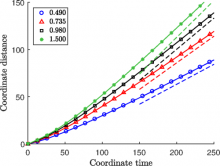
Abstract
When two relativistically boosted, nonspinning black holes pass by one another on a scattering trajectory, we might expect the tidal interaction to spin up each black hole. We present the first exploration of this effect, appearing at fourth post-Newtonian order, with full numerical relativity calculations. The basic setup for the calculations involves two free parameters: the initial boost of each black hole and the initial angle between the velocity vectors and a line connecting the centers of the black holes, with zero angle corresponding to a head-on trajectory. To minimize gauge effects, we measure final spins only if the black holes reach a final separation of at least 20M. Fixing the initial boost, we find that as the initial angle decreases toward the scattering/nonscattering limit, the spin-up grows nonlinearly. In addition, as initial boosts are increased from 0.42c to 0.78c, the largest observed final dimensionless spin on each black hole increases nonlinearly from 0.02 to 0.20. Based on these results, we conclude that much higher spin-ups may be possible with larger boosts, although achieving this will require improved numerical techniques.